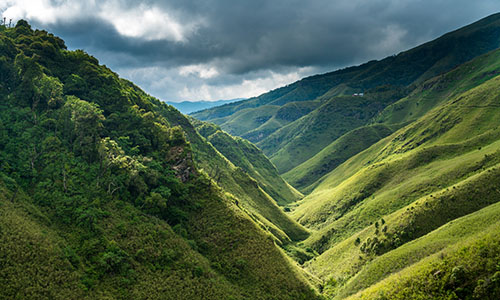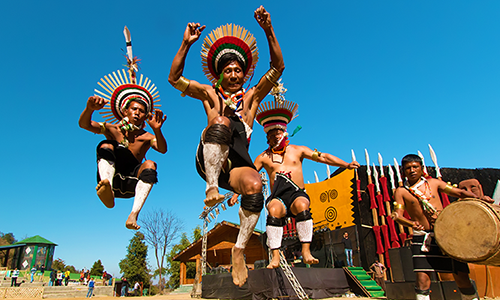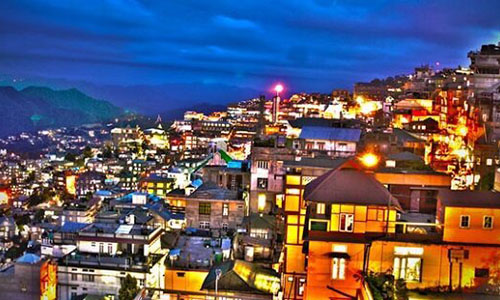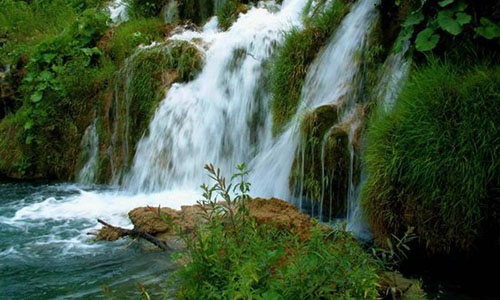Nagaland
“Gateway to the Heart of India”
Nagaland Tourism-A Glimpse
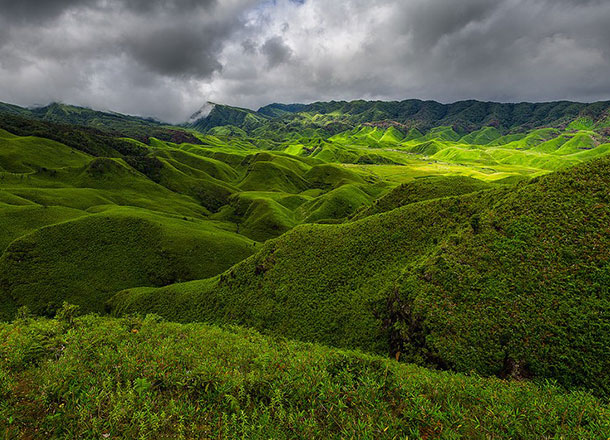 Inhabited by the tribes who are very protective towards their culture and identity, Nagaland is another name for beauty and bounty. Colorful costumes, spicy cuisines, pleasant weather, traditional villages, beautiful dance forms and lyrical songs are all that define the north-eastern state of Nagaland.
Inhabited by the tribes who are very protective towards their culture and identity, Nagaland is another name for beauty and bounty. Colorful costumes, spicy cuisines, pleasant weather, traditional villages, beautiful dance forms and lyrical songs are all that define the north-eastern state of Nagaland.
Japfu Peak, Dzukou Valley, Shilloi Lake are some of the places for nature lovers while the villages of Nagaland add rustic charm to your trip. Like other north-eastern states, Nagaland is also rich in culture with the variety of tribes adding colours in it. The artistic skills of local people will not only amaze you but excite you to learn their way of weaving and carving which is simply mesmerizing.
As all the tribes have their own festivals and ceremonies, Nagaland is always ready to welcome a festival with great joy, and gaiety and food remains as much a part of the festival as the dances and songs. Naga people eat almost anything that they can lay their hands on, be it dog, pork, snails or even an elephant and no part of the animal is wasted be it the skin or intestine. It shows how much they relish food and drinks. These jolly, colourful and simple people are the soul of the state while nature attracts tourists from all over the world.
Local Food and Cuisine of Nagaland
The countless tribes of Nagaland give its cuisine unique flavors, colors, styles and a distinct dash of adventure. The Naga cuisine is primarily non-vegetarian and goes beyond the typical non vegetarian ingredients with dogs, spiders, pork, beef, crabs, cats, chicken and even elephants in its platter.
The food here is generously hot and spicy, given the usage of Naga King Chili in most of its dishes. The everyday food of Naga people is rice with meat or vegetables. Smoke dried pork curry with Akhuni (fermented soya beans), Rice beer and snails are the traditional aspects of Nagaland’s cuisine. Koat pitha is a popular sweet dish to be relished, made with bananas, rice flour, and jaggery. Dried pork, smoked pork stew, boiled vegetables, bamboo steamed fish, roasted intestines, beans mix, bitter melon, chicken rice soup, crab chilly sauce, naga ghost chillie sauce are the unique treasures of the area’s cuisine. Also, it is safe to say that the options for vegetarian food here are limited and will not offer the same variety as in case of local non-vegetarian food.
What’s Great?
Untouched natural beauty and plenty of wildlife. Pleasant climate throughout the year. Culturally diverse region with many tribes.
What’s not so Great?
Difficult to access because of poor road and rail connectivity. Occasional violence and political instability.
For Whom?
For the adventure enthusiasts, there are plenty of trek routes. The large area under forest cover ensures a lot of endemic undisturbed wildlife for the nature lovers. The 16 tribes living in this state also offer a lot of different cultural traditions.
People and Culture of Nagaland
The population of Nagaland is entirely tribal. The prominent tribes of Nagaland state include Chakhesang, Angami, Zeliang, Ao, Sangtam, Yimchunger, Chang, Sema, Lotha, Khemungan, Rengma, Konyak, Pochury and Phom. Christianity is the prime religion followed by a majority of Nagaland people. Nagamese is the language which is spoken by almost all the people of Nagaland.
The weaving industry is one of the important industries of Nagaland, and the art of weaving is primarily the domain of the female folk of Nagaland. Wood carving is one of the traditional arts of Nagaland which produces beautiful products that have an internationally acclaimed status. Naga people excel in almost all sorts of art and craft be it weaving, embroidery, wood carving, basketry, bamboo works, cane works, pottery and metalwork.
Geography of Nagaland
Nagaland is one of the seven North-Eastern states of India and is bordered by the states of Assam, Arunachal Pradesh and Manipur and shares an international boundary with Myanmar on its eastern side. The capital of this state is Kohima, and the largest city, the hub of commercial and tourist activity is Dimapur. The state is predominantly a mountainous region and consists of the Naga and Patkai hill ranges. Many rivers like Doyang, Diphu and Barak, flow through these mountains and join the Brahmaputra, making the state a lush green haven for wildlife.
History of Nagaland
The history of individual Naga tribes is unclear, but there are records of them having lived together, though there were frequent inter-tribe battles. The British East India Company tried to establish control over this strategic region for a long time but were successfully repelled by the Naga tribes. The British presence in the area was very limited, and a policy of non-interference was widely followed, and this led to the preservation of Naga tribal culture till date.
After independence, there were many conflicts between the government and amongst tribals but an autonomous region within the state of Assam was established to give administrative independence to the tribal population. Eventually, this area was granted statehood on 1 December 1963. Insurgent activity was common in the state until the last decade impeding economic growth but peace has now been established, and this has resulted in a dramatic rise in tourism, which is currently an important part of the state economy.
Costumes of Nagaland
The tribes of Nagaland are the main reason why tourists visit the state, and their unique cultural practices, food and colourful costumes are a delight to all those who venture to this part of the North east. Each of the tribes and sub-tribes has their unique way of dressing, and it is how they preserve their identity. The dress consists of a blend of natural fabrics and other animal and plant products. Beads, shells, teeth and bones of animals, feathers and flower feature prominently in all tribal costumes.
In the past, each of these adornments had to be earned by the individuals by showing feats of valour and were worn as badges of honour. Since the awareness of nature conservation has reached the tribes, they have mostly stopped the killing of animals for using their parts in costumes and now use differently made products to the same dazzling effect. An unusual thing is the emergence of the fashion industry in this state which blends the ethnic styles of the tribes with the demands of the present market. Many Naga youth are now prominent names in the country’s fashion industry.
Hornbill Festival: Festival of Festivals
This initiative was undertaken by the Government of Nagaland to promote tourism in the state using the myriad of cultures and festivals that are celebrated by different tribes of Nagaland. This 10-day long fest coincides with the Statehood Day – 1st December – and continues until 10th December. Tribes from all over this state as well from the other North Eastern States are invited to this festival to showcase their traditions and ways of celebrating. It is held at the foothills of Mount Japfü near Kohima and is a must visit for all tourists who visit the state. All tribes come in traditional attire with musical instruments, food and dances to showcase making it a one-stop event to experience the whole range of Naga culture.
Naga Heritage Village
This village was specially built to preserve the unique culture, language, costumes and lifestyle of all tribes and sub-tribes of Nagaland and is located 10 kilometres from Kohima. This is the venue of the famous Hornbill Festival and has been developed as a tourist and cultural centre. It has also become a symbol of unity among the various tribes who work together for economic progress and respect each other’s traditions.
The complex has sixteen clusters of houses and halls built according to the architectural styles typical of each of the sixteen major tribes. It also has the traditional adornments, furniture and symbolism. This complex also houses many other sporting, musical and fashion events throughout the year.
Unspoilt Nature
Over 20% of the land in this state is covered by lush tropical and subtropical rainforests and these forests are home to some very rare and endangered species of animals and birds. Since Nagaland is a relatively unexplored destination, the forests there are unspoilt and not commercialised. Frequently referred to as the Switzerland of the East for its unparalleled natural beauty, Nagaland is a haven for wildlife enthusiasts.
Rare birds like the Amur Falcon and Greater Hornbill come in large numbers to roost in these forests. The Intanki National Park is the largest reserved forest area, and it has many large and small animals like tigers, sloth bears, monitor lizards and a variety of rare endemic snakes. The landscape of urban areas too are lined with greenery, and this makes a trip to this state a feast for the eyes.

